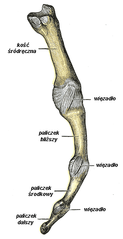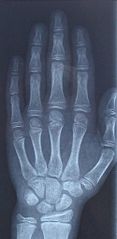Palec ręki
| Ten artykuł od 2012-10 wymaga zweryfikowania podanych informacji. |
| ||
 Budowa palca człowieka | ||
 Zdjęcie rentgenowskie ludzkiej ręki | ||
Palec ręki – u człowieka i innych zwierząt zakończenie ręki zwieńczone pazurami, paznokciami, kopytami itp. Liczba palców ręki może wynosić od jednego (np. u konia) do pięciu (naczelne).
W rozumieniu potocznym palce stanowią tylko przystosowane do chwytania zakończenia rąk gatunków naczelnych.
Człowiek posiada pięć palców, wyjątek stanowią osoby z polidaktylią czy syndaktylią.
Nazwy palców
Etymologia
Pierwotnie nazwa palec w języku polskim odnosiła się do kciuka (stąd zgrubienie paluch i powiedzenie: Sam jak palec). Zaś pozostałe palce określane były formą pochodną z prasłowiańskiego *prst[1], świadectwa tego zachowały się w innych językach słowiańskich, por. cz. prst, chorw. prst oraz bałtyckich lit. pirštas. Pozostałością nazwy *prst w polskim są takie słowa jak pierścień, naparstek[1].
Zmiana nazwy nastąpiła pod wpływem religii chrześcijańskiej. Paluch jest bowiem palcem używanym w trakcie obrzędu chrztu do kreślenia znaku krzyża na czole, stąd powstały dawne formy krzciuk skrócone do współczesnej kciuk.[2]
| Zdjęcie | Nazwa polska | Nazwa łacińska |
|---|---|---|
(c) Michiel1972, CC-BY-SA-3.0 | Kciuk | Pollex, digitus primus, digitus I |
| Palec wskazujący | Index, Digitus secundus, digitus II | |
 | Palec środkowy | Digitus medius, digitus tertius, digitus III |
(c) Michiel1972, CC-BY-SA-3.0 | palec serdeczny | Digitus annularis, digitus quartus, digitus IV |
 | Palec mały | Digitus minimus manus, digitus quintus, digitus V |
Budowa palców
U człowieka
Kościec kciuka człowieka składa się z dwóch paliczków. Na pozostałe palce ręki składają się po trzy paliczki.
Rodzaje paliczków:
- paliczek bliższy (phalanx proximalis)
- paliczek środkowy (phalanx media)
- paliczek dalszy (phalanx distalis)
Zobacz też
- dotyk
- opuszki kończynowe
Przypisy
- ↑ a b dr Maciej Malinowski: Zostaniesz kiedyś sam jak palec (pol.). Obcy język polski, 2002-07-17. [dostęp 2020-10-06].
- ↑ Wiesław Boryś: Słownik etymologiczny języka polskiego. Kraków: Wydawnictwo Literackie, 2005. ISBN 83-08-03648-1.
![]() Przeczytaj ostrzeżenie dotyczące informacji medycznych i pokrewnych zamieszczonych w Wikipedii.
Przeczytaj ostrzeżenie dotyczące informacji medycznych i pokrewnych zamieszczonych w Wikipedii.
Media użyte na tej stronie
Star of life, blue version. Represents the Rod of Asclepius, with a snake around it, on a 6-branch star shaped as the cross of 3 thick 3:1 rectangles.
Design:
The logo is basically unicolor, most often a slate or medium blue, but this design uses a slightly lighter shade of blue for the outer outline of the cross, and the outlines of the rod and of the snake. The background is transparent (but the star includes a small inner plain white outline). This makes this image usable and visible on any background, including blue. The light shade of color for the outlines makes the form more visible at smaller resolutions, so that the image can easily be used as an icon.
This SVG file was manually created to specify alignments, to use only integers at the core 192x192 size, to get smooth curves on connection points (without any angle), to make a perfect logo centered in a exact square, to use a more precise geometry for the star and to use slate blue color with slightly lighter outlines on the cross, the rod and snake.
Finally, the SVG file is clean and contains no unnecessary XML elements or attributes, CSS styles or transforms that are usually added silently by common SVG editors (like Sodipodi or Inkscape) and that just pollute the final document, so it just needs the core SVG elements for the rendering. This is why its file size is so small.The Star of Life, medical symbol used on some ambulances.
Star of Life was designed/created by a National Highway Traffic Safety Administration (US Gov) employee and is thus in the public domain.Metacarpophalangeal articulation and articulations of digit. Ulnar aspect.












